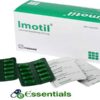Ucol 2mg Tablet 10pcs
৳ 30.10
Ingredients : Tolterodine Tartrate 2 mg
Manufacturer : Square Pharmaceuticals Limited
Indications
Therapeutic Class
Pharmacology
Dosage & Administration
The recommended total daily dose of tolterodine is 2 mg (1 mg b.i.d.) for patients with impaired renal function, impaired liver function, or receiving concomitant medication with potent CYP3A inhibitors, such as macrolide antibiotics (e.g. erythromycin and clarithromycin) or azole antifungal agents (e.g. ketoconazole, itraconazole and miconazole). After six months the need for further treatment should be considered.
Interaction
Ketoconazole, a potent inhibitor of CYP3A, significantly increased plasma concentrations of tolterodine when coadministered to poor metabolisers (i.e. persons devoid of CYP2D6 metabolic pathway).
Clinical studies have shown no interactions with warfarin or combined oral contraceptives (ethinyloestradiol or levonorgestrel).
Contraindications
Side Effects
Pregnancy & Lactation
Use of tolterodine during lactation should be avoided since no data on excretion of the drug into breast milk in humans is available.
Precautions & Warnings
- at risk for urinary retention
- at risk for decreased gastrointestinal motility
- with impaired renal function
- with impaired hepatic function
Organic reasons for urge and frequency should be considered before treatment.
Use in Special Populations
Geriatric use: No overall differences in safety were observed between the older and younger patients treated with Tolterodine.
Overdose Effects
Storage Conditions
Brand
Square Pharmaceuticals Ltd













